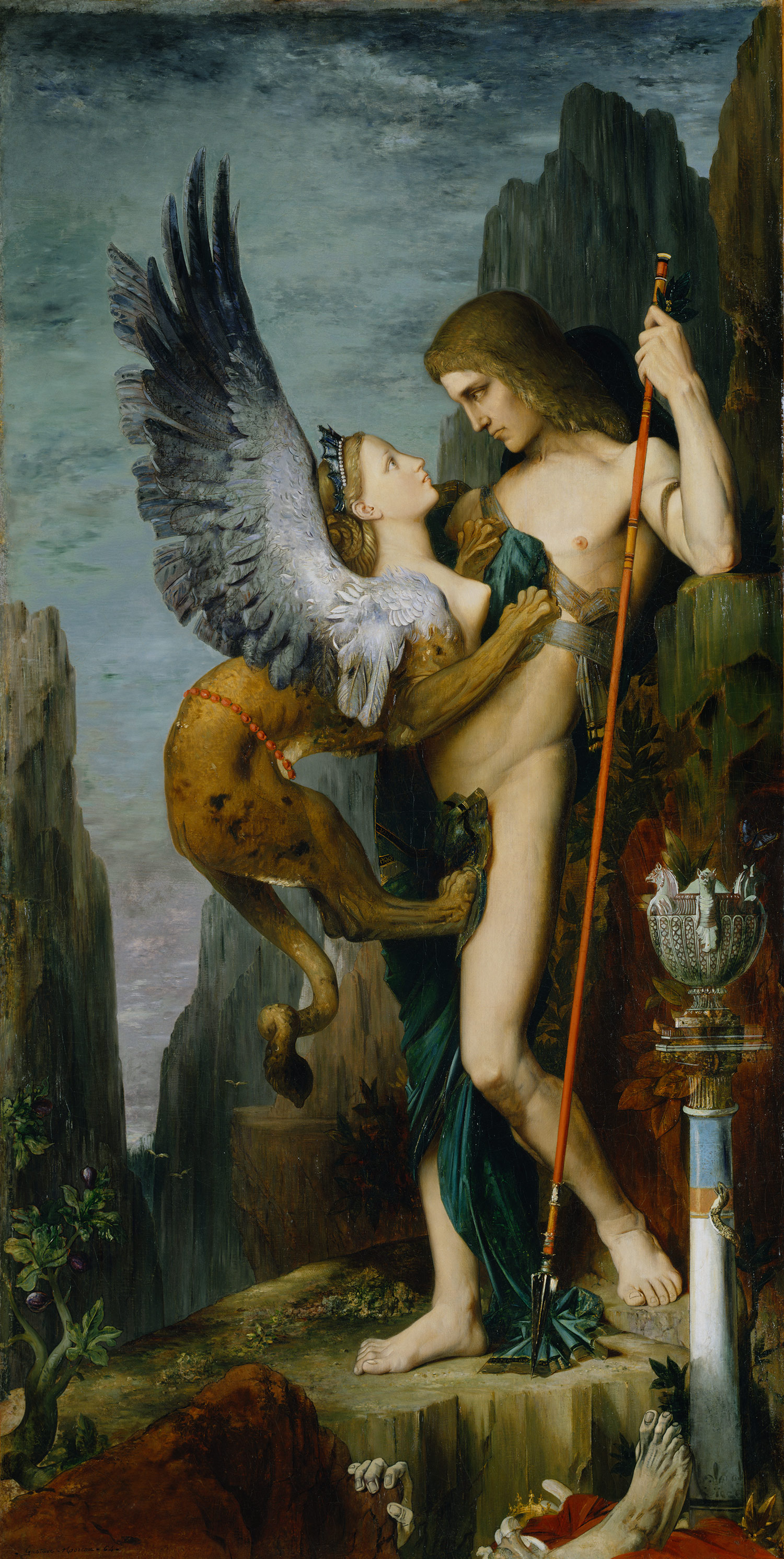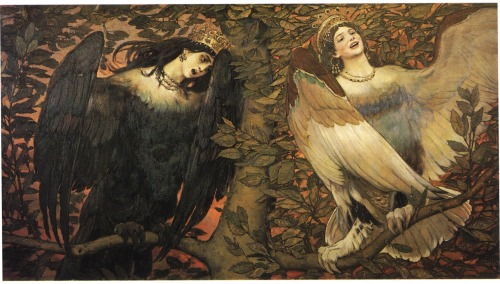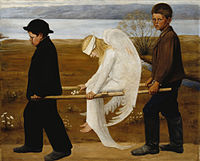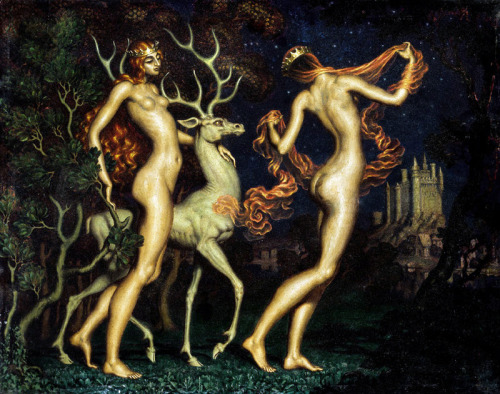Origins
The term "symbolism" is derived from the word "symbol" which derives from the Latin symbolum, a symbol of faith, and symbolus, a sign of recognition, in turn from classical Greek συμβόλων symbolon, an object cut in half constituting a sign of recognition when the carriers were able to reassemble the two halves. In ancient Greece, the symbolon, was a shard of pottery which was inscribed and then broken into two pieces which were given to the ambassadors from two allied city states as a record of the alliance.
The term "symbolism" is derived from the word "symbol" which derives from the Latin symbolum, a symbol of faith, and symbolus, a sign of recognition, in turn from classical Greek συμβόλων symbolon, an object cut in half constituting a sign of recognition when the carriers were able to reassemble the two halves. In ancient Greece, the symbolon, was a shard of pottery which was inscribed and then broken into two pieces which were given to the ambassadors from two allied city states as a record of the alliance.
Symbolism is the practice
of representing things by symbols, or of investing things with a symbolic
meaning or character. A symbol is an object, action, or idea that
represents something other than itself, often of a more abstract nature.
Symbolism creates quality aspects that make literature like poetry and novels
more meaningful.
Symbolism initially developed as a French literary movement in the 1880s, gaining popular credence with the publication in 1886 of Jean Moréas' manifesto in Le Figaro. Reacting against the rationalism and materialism that had come to dominate Western European culture, Moréas proclaimed the validity of pure subjectivity and the expression of an idea over a realistic description of the natural world. This philosophy, which would incorporate the poet Stéphane Mallarmé's conviction that reality was best expressed through poetry because it paralleled nature rather than replicating it, became a central tenet of the movement. In Mallarmé's words, "To name an object is to suppress three-quarters of the enjoyment to be found in the poem... suggestion, that is the dream."
Gustave Moreau
Symbolism in art
Symbolism was a late nineteenth-century art movement of French, Russian and Belgian origin in poetry and other arts. In literature, the style had its beginnings with the publication Les Fleurs du mal (The Flowers of Evil, 1857) by Charles Baudelaire. The works of Edgar Allan Poe, which Baudelaire admired greatly and translated into French, were a significant influence and the source of many stock tropes and images. The aesthetic was developed by Stéphane Mallarmé and Paul Verlaine during the 1860s and '70s. In the 1880s, the aesthetic was articulated by a series of manifestos and attracted a generation of writers. The name "symbolist" itself was first applied by the critic Jean Moréas, who invented the term to distinguish the symbolists from the related decadents of literature and of art. Distinct from, but related to, the style of literature, symbolism of art is related to the gothic component of Romanticism.
Symbolism was largely a reaction
against naturalism and realism, anti-idealistic
styles which were attempts to represent reality in its gritty particularity,
and to elevate the humble and the ordinary over the ideal. Symbolism was a
reaction in favour of spirituality, the imagination, and
dreams. Some writers, such as Joris-Karl Huysmans, began as naturalists before becoming
symbolists; for Huysmans, this change represented his increasing interest in
religion and spirituality. Certain of the characteristic subjects of the decadents represent
naturalist interest in sexuality and taboo topics, but in their case this was
mixed with Byronic romantism and the
world-weariness characteristic of the fin de siecle period.
Carlos Schwabe
Carlos Schwabe
Jean Moréas published the Symbolist Manifesto ("Le Symbolisme") in Le Figaro on 18 September 1886. Moréas announced that symbolism was hostile to "plain meanings, declamations, false sentimentality and matter-of-fact description", and that its goal instead was to "clothe the Ideal in a perceptible form" whose "goal was not in itself, but whose sole purpose was to express the Ideal":
(In this art, scenes
from nature, human activities, and all other real world phenomena will not be described
for their own sake; here, they are perceptible surfaces created to represent
their esoteric affinities with the primordial Ideals.)
Techiques
The symbolist poets wished to liberate techniques of versification in order to allow greater room for "fluidity", and as such were sympathetic with the trend toward Free verse, as evident by the poems of Gustave Kahn and Erza Pound. Symbolist poems were attempts to evoke, rather than primarily to describe; symbolic imagery was used to signify the state of the poet's soul. T.S. Eliot was one of these poets, although it has also been said that ' Imaginism' was the style to which both Pound and Eliot subscribed (see Pound's Des Imagistes). Synesthesia was a prized experience; poets sought to identify and confound the separate senses of scent, sound, and colour.
In Baudelaire's poemCorrespondences, which also mentions forêts de symboles — forests of symbols —
Il est des parfums frais comme des chairs d'enfants,
Doux comme les hautbois, verts comme les prairies,
— Et d'autres, corrompus, riches et triomphants,
Ayant l'expansion des choses infinies,
Comme l'ambre, le musc, le benjoin et l'encens,
Qui chantent les transports de l'esprit et des sens.
Verlaine argued that in their individual and very different ways, each of these hitherto neglected poets found genius a curse; it isolated them from their contemporaries, and as a result these poets were not at all concerned to avoid hermeticism and idiosyncratic writing styles. They were also portrayed as at odds with society, having tragic lives, and often given to self-destructive tendencies. These traits were not hindrances but consequences of their literary gifts. Verlaine's concept of the poète maudit in turn borrows from Baudelaire, who opened his collection Les fleurs du mal with the poem Bénédiction, which describes a poet whose internal serenity remains undisturbed by the contempt of the people surrounding him.
In this conception of genius and the role of the poet, Verlaine referred indirectly to the aesthetics of Arthur Schopenhauer, the philosopher of pessimism, who maintained that the purpose of art was to provide a temporary refuge from the world of strife of the will.
Hugo Simberg
Nicholas Kalmakoff
Techiques
The symbolist poets wished to liberate techniques of versification in order to allow greater room for "fluidity", and as such were sympathetic with the trend toward Free verse, as evident by the poems of Gustave Kahn and Erza Pound. Symbolist poems were attempts to evoke, rather than primarily to describe; symbolic imagery was used to signify the state of the poet's soul. T.S. Eliot was one of these poets, although it has also been said that ' Imaginism' was the style to which both Pound and Eliot subscribed (see Pound's Des Imagistes). Synesthesia was a prized experience; poets sought to identify and confound the separate senses of scent, sound, and colour.
In Baudelaire's poemCorrespondences, which also mentions forêts de symboles — forests of symbols —
Il est des parfums frais comme des chairs d'enfants,
Doux comme les hautbois, verts comme les prairies,
— Et d'autres, corrompus, riches et triomphants,
Ayant l'expansion des choses infinies,
Comme l'ambre, le musc, le benjoin et l'encens,
Qui chantent les transports de l'esprit et des sens.
(There are perfumes that
are fresh like children's flesh,
sweet like oboes, green like meadows
— And others, corrupt, rich, and triumphant,
having the expansiveness of infinite things,
like amber, musc, benzoin, and incense,
which sing of the raptures of the soul and senses.)
sweet like oboes, green like meadows
— And others, corrupt, rich, and triumphant,
having the expansiveness of infinite things,
like amber, musc, benzoin, and incense,
which sing of the raptures of the soul and senses.)
and Rimbaud's poem Voyelles:
A noir, E
blanc, I rouge, U vert, O bleu : voyelles. . .
(A black, E white, I red,
U green, O blue: vowels. . .)
— both poets seek to identify one
sense experience with another. The earlier Romantiscism of poetry used symbols, but
these symbols were unique and privileged objects. The symbolists were more
extreme, investing all things, even vowels and perfumes, with potential
symbolic value. "The physical universe, then, is a kind of language that
invites a privileged spectator to decipher it, although this does not yield a
single message so much as a superior network of associations." Symbolist symbols are not allengories,
intended to represent; they are instead intended to evoke particular states of mind. The nominal
subject of Mallarmé's "Le cygne" ("The Swan")
is of a swan trapped in a frozen lake. Significantly, in French, cynge is
a homophone of signe, a sign. The overall effect is of
overwhelming whiteness; and the presentation of the narrative elements of the
description is quite indirect:
Le
vierge, le vivace, et le bel aujourd’hui
Va-t-il nous déchirer avec un coup d’aile ivre
Ce lac dur oublié que hante sous le givre
Le transparent glacier des vols qui n’ont pas fui!
Un cygne d’autrefois se souvient que c’est lui
Magnifique mais qui sans espoir se délivre...
Va-t-il nous déchirer avec un coup d’aile ivre
Ce lac dur oublié que hante sous le givre
Le transparent glacier des vols qui n’ont pas fui!
Un cygne d’autrefois se souvient que c’est lui
Magnifique mais qui sans espoir se délivre...
("The virgin, lively,
and beautiful today – will it tear for us this hard forgotten lake that lurks
beneath the frost, the transparent glacier of flights not taken with a blow
from a drunken wing? A swan of long ago remembers that it is he, magnificent
but without hope, who breaks free...)
Viktor
Vasnetsov
Paul Verlaine and the poètes maudits
Of the several attempts at defining the essence of symbolism, perhaps none was more influential than Paul Verlaine's 1884 publication of a series of essays on Tristan Corbière, Arthur Rimbaud,Stéphane Mallarmé, Marceline Desbordes-Valmore, Gérard de Nerval, and "Pauvre Lelian" ("Poor Lelian", an anagram of Paul Verlaine's own name), each of whom Verlaine numbered among thepoètes maudits, "accursed poets."
Verlaine argued that in their individual and very different ways, each of these hitherto neglected poets found genius a curse; it isolated them from their contemporaries, and as a result these poets were not at all concerned to avoid hermeticism and idiosyncratic writing styles. They were also portrayed as at odds with society, having tragic lives, and often given to self-destructive tendencies. These traits were not hindrances but consequences of their literary gifts. Verlaine's concept of the poète maudit in turn borrows from Baudelaire, who opened his collection Les fleurs du mal with the poem Bénédiction, which describes a poet whose internal serenity remains undisturbed by the contempt of the people surrounding him.
In this conception of genius and the role of the poet, Verlaine referred indirectly to the aesthetics of Arthur Schopenhauer, the philosopher of pessimism, who maintained that the purpose of art was to provide a temporary refuge from the world of strife of the will.
Philosophy
Schopenhauer's aesthetics represented shared concerns with the symbolist programme; they both tended to consider Art as a contemplative refuge from the world of strife and will. As a result of this desire for an artistic refuge, the symbolists used characteristic themes of mysticism and other worldliness, a keen sense of mortality, and a sense of the malign power of sexuality, which Albert Samain termed a "fruit of death upon the tree of life."
Schopenhauer's aesthetics represented shared concerns with the symbolist programme; they both tended to consider Art as a contemplative refuge from the world of strife and will. As a result of this desire for an artistic refuge, the symbolists used characteristic themes of mysticism and other worldliness, a keen sense of mortality, and a sense of the malign power of sexuality, which Albert Samain termed a "fruit of death upon the tree of life."
Hugo Simberg
Visual
arts
Symbolism in literature is distinct from symbolism in art although the two were similar in many respects. In painting, symbolism can be seen as a revival of some mystical tendencies in the Romantic tradition, and was close to the self-consciously morbid and private decadent movement.
There were several rather dissimilar groups of Symbolist painters and visual artists, which included Gustave Moreau, Gustav Klimt, Mikalojus Konstantinas Čiurlionis, Odilon Redon, Pierre Puvis de Chavannes, Henri Fantin-Latour, Gaston Bussière (painter), Edvard Munch, Félicien Rops, and Jan Toorop. Symbolism in painting was even more widespread geographically than symbolism in poetry, affecting Mikhail Vrubel, Nicholas Roerich, Victor Borisov-Musatov, Martiros Saryan, Mikhail Nesterov, Leon Bakst, Elena Gorokhova in Russia, as well as Frida Kahlo in Mexico, Elihu Vedder, Remedios Varo, Morris Graves and David Chetlahe Paladin in the United States. Auguste Rodin is sometimes considered a symbolist sculptor.
The symbolist painters used mythological and dream imagery. The symbols used by symbolism are not the familiar emblems of mainstream iconography but intensely personal, private, obscure and ambiguous references. More a philosophy than an actual style of art, symbolism in painting influenced the contemporaryArt Nouveau style and Les Nabis.
Symbolism in literature is distinct from symbolism in art although the two were similar in many respects. In painting, symbolism can be seen as a revival of some mystical tendencies in the Romantic tradition, and was close to the self-consciously morbid and private decadent movement.
There were several rather dissimilar groups of Symbolist painters and visual artists, which included Gustave Moreau, Gustav Klimt, Mikalojus Konstantinas Čiurlionis, Odilon Redon, Pierre Puvis de Chavannes, Henri Fantin-Latour, Gaston Bussière (painter), Edvard Munch, Félicien Rops, and Jan Toorop. Symbolism in painting was even more widespread geographically than symbolism in poetry, affecting Mikhail Vrubel, Nicholas Roerich, Victor Borisov-Musatov, Martiros Saryan, Mikhail Nesterov, Leon Bakst, Elena Gorokhova in Russia, as well as Frida Kahlo in Mexico, Elihu Vedder, Remedios Varo, Morris Graves and David Chetlahe Paladin in the United States. Auguste Rodin is sometimes considered a symbolist sculptor.
The symbolist painters used mythological and dream imagery. The symbols used by symbolism are not the familiar emblems of mainstream iconography but intensely personal, private, obscure and ambiguous references. More a philosophy than an actual style of art, symbolism in painting influenced the contemporaryArt Nouveau style and Les Nabis.
Nicholas Kalmakoff
*Major Points
The symbolist movement began in
the late 19th centenary and began in France in 1885 and it’s said to
have lasted till 1925. But Symbolism is an art style that still incorporates
into many modern artists of today.
A movement created in response to
realism and romanticism. The artist’s created imagery that didn’t have to come
from reality which gave the artists a sense of anarchy at the time.
Symbolist’s were known for
blending fact and fiction with reality and mythology and giving their subject
matter higher meanings.
Symbolism and Surrealism are
usually linked because of the visuals usually coming from the artists
imagination. But Surrealism seems to be heavily inspired by Symbolism since it
is the movement that came first.
Symbolist's also use different
forms of imagery it being objects or figures that are showing deeper meanings
of their own views or to portray messages.





No comments:
Post a Comment